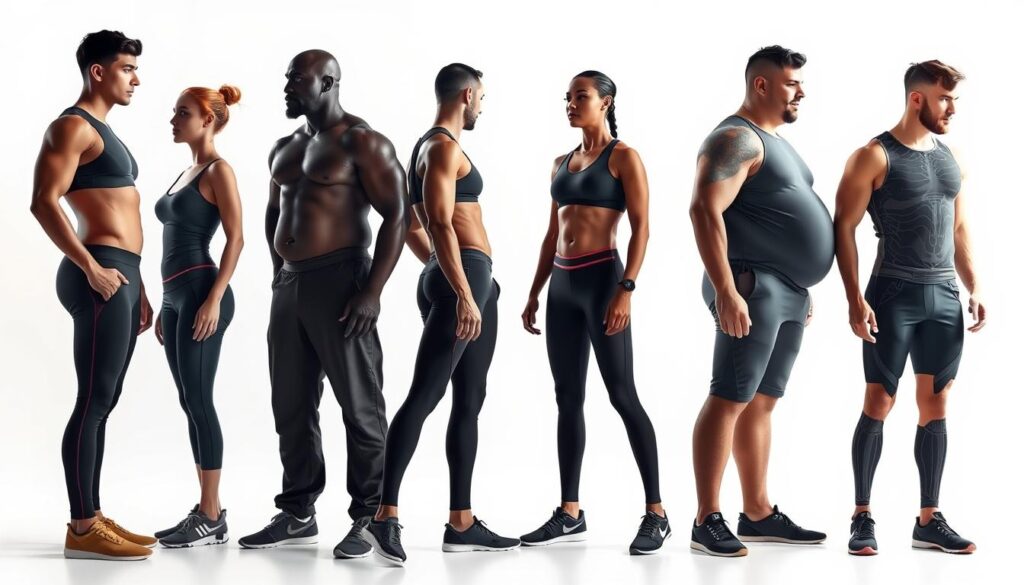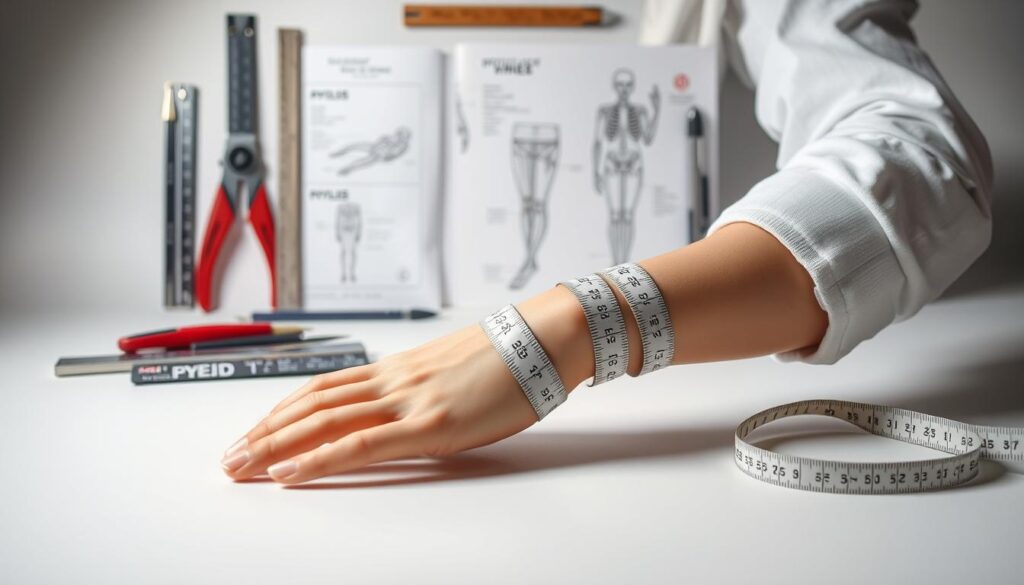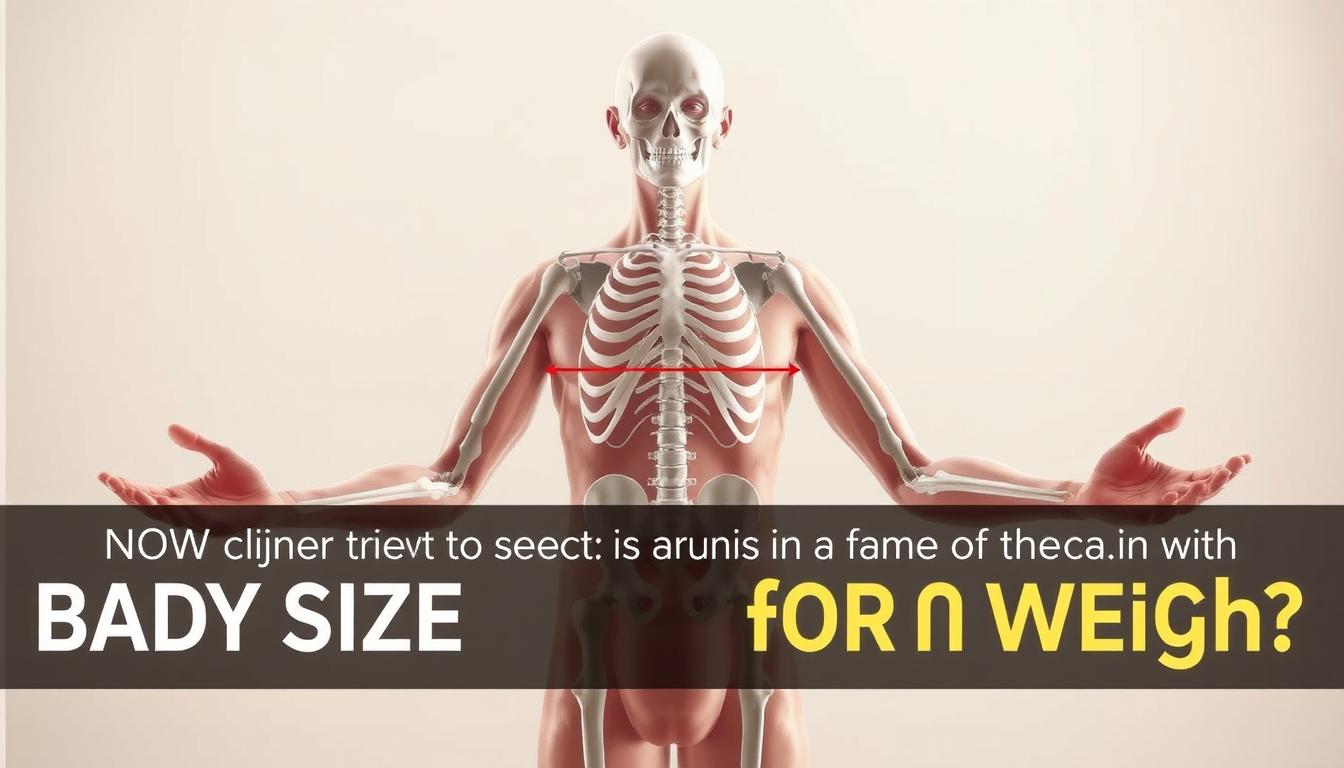Did you know two people with identical heights can have vastly different healthy weight targets? The secret lies in body frame measurements – a critical factor most weight charts ignore. Your bone structure impacts what your physique can naturally support, making wrist circumference and shoulder width essential metrics.
We’ll guide you through reliable methods to assess your unique build. From manual techniques using everyday objects to validated digital tools, you’ll discover multiple ways to personalize your health targets. Understanding these parameters helps create realistic goals that align with your bone structure and height.
Our approach combines physical measurement strategies with modern calculator formulas used by nutritionists. Whether you’re tracking fitness progress or planning dietary changes, knowing your frame classification provides clarity. Let’s explore how wrist ratios, elbow breadth, and height-weight relationships paint a complete picture.
Key Takeaways
- Wrist circumference reveals whether you have a small, medium, or large frame
- Online calculators simplify frame size analysis using height and wrist data
- Ideal weight ranges adjust significantly based on bone structure
- Manual measurements require only a tape measure and simple math
- Multiple methods exist to cross-verify results for accuracy
Understanding Body Frame Size and Its Impact on Ideal Weight
Your bone structure holds hidden clues about your healthy weight range. While body mass index (BMI) remains a common health metric, it overlooks critical variations in skeletal dimensions. This gap explains why two people with identical heights might need different weight goals.

What Is Body Frame Size?
Body frame size reflects the natural width and density of your bones. Clinicians typically measure wrist circumference or elbow breadth to categorize builds as small, medium, or large. For example, a woman with a 6-inch wrist likely has a smaller frame than someone measuring 7.5 inches, even at the same height.
Why Frame Size Matters for Health and Weight
Larger frames often support higher bone density, naturally carrying more muscle mass. This means a person with broad shoulders might weigh more than BMI charts suggest—without excess body fat. Genetics largely determine these traits, making personalized assessments essential for realistic targets.
Traditional weight guidelines frequently underestimate this biological diversity. A 2023 study found that individuals with larger frames showed 18% higher bone mineral content than smaller-framed peers. Recognizing these differences helps create health plans that respect your body’s unique architecture.
How to calculate frame size for ideal weight: Methods and Techniques
Three proven techniques help classify skeletal structure without specialized equipment. These approaches combine physical measurements with biological considerations, offering both precision and convenience for personal health planning.

Measuring Your Wrist and Determining Frame Categories
Wrap a flexible tape around your wrist’s narrowest point, ensuring snug contact without compression. Record the number in inches—this measurement becomes crucial when paired with height data through standardized charts or digital tools. For example, a 5’8″ adult with a 6.5-inch wrist typically falls into the medium category.
Using the Finger and Thumb Test for Quick Assessment
Grasp your opposite wrist with thumb and middle finger. If fingertips overlap easily, you likely have a small frame. A slight touch suggests medium build, while a gap indicates larger bone structure. Though less precise than tape measurements, this method works well for immediate estimations.
Considering Age, Gender, and Body Composition Factors
Muscle mass significantly impacts interpretation—athletes might register larger frames due to developed forearm tissues rather than bone density. Women generally have narrower wrist measurements than men at comparable heights, while aging adults should account for potential bone density changes. Always cross-reference results with body mass index calculations for holistic analysis.
These strategies create actionable data when combined with modern health metrics. For those seeking enhanced precision, validated digital tools and ratio-based formulas offer the next level of detail—a natural progression we’ll explore next.
Tools and Formulas for Accurate Frame Size Measurement
Modern health assessments blend technology with proven formulas to deliver precise skeletal evaluations. Leading platforms like Medindia offer specialized BMI calculators that factor in wrist measurements and gender differences. These digital tools process your height-weight data through algorithms derived from Hamwi and Devine equations.
Validated Formulas and Online Calculators
Nutritionists often use the Robinson formula for women and Devine method for men to estimate ideal ranges. A typical weight calculator asks for three inputs: height, wrist circumference, and biological sex. For example, a 5’7″ female with a 6.2-inch wrist would receive different targets than a male counterpart with identical measurements.
Interpreting Charts and Ratios for Small, Medium, and Large Frames
Standardized charts visually map height against wrist size across three categories. A medium frame might show 5’10” males needing 7-7.5″ wrists, while large frames require broader measurements. These ratios help explain why two people at the same weight can have vastly different health profiles.
When using online tools, always cross-reference results with manual calculations. Body composition nuances—like muscle mass versus bone density—can skew digital readings. Most platforms now include adjustment sliders for athletic builds or pregnancy considerations.
Reputable sources provide downloadable height-weight tables categorized by frame type. These resources empower users to track progress while accounting for their unique bone structure. By combining digital convenience with scientific rigor, today’s tools make personalized health planning accessible to all.
Conclusion
Personalized health goals begin with recognizing your body’s natural blueprint. Assessing bone structure through wrist measurements or digital tools creates realistic targets that respect biological diversity. Muscle composition, fat distribution, and body mass all influence what “healthy” means for you.
Age and fitness levels further refine these metrics. A 25-year-old athlete’s needs differ from a 60-year-old’s due to natural muscle decline. Our guide’s reliable weight calculators help navigate these variables, while regular monitoring supports long-term success.
Remember: weight loss efforts thrive when paired with frame-aware strategies. Broad shoulders or narrow wrists demand tailored nutrition and exercise plans. Tools like the health risk analyzer add depth to basic BMI data, addressing its muscle-fat blind spots.
Use these insights to build sustainable habits. Track progress, adjust for life changes, and celebrate milestones aligned with your unique physique. Health isn’t one-size-fits-all—it’s a dynamic balance of science and self-awareness.

